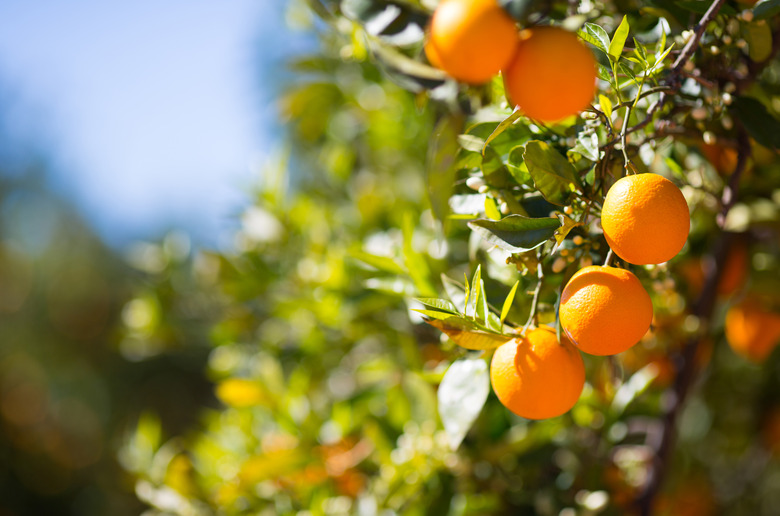How To Grow Oranges
Both attractive and tasty, orange trees (Citrus sinensis) make a great addition to backyard gardens and orchards. With attractive evergreen leaves, white flower blossoms and bright-orange fruit, an orange tree provides visual interest all year long. It also provides sweet citrus fruit that you can eat right off the tree or that you can juice for a healthy and delicious dose of vitamin C. It's no secret that citrus needs warm weather, but northern-region gardeners can rest assured that they can grow oranges indoors and still produce fruit that they crave.
Best Uses for Oranges
Being evergreen, orange trees do add some visual interest to the landscape. Gardeners primarily grow them for their sweet fruit, however, and not merely as a decorative plant. A single tree can easily produce 100 oranges or more in a year. Orange trees can live for 100 years or more but usually bear meaningful amounts of fruit for only 25 to 30 years.
Standard citrus trees grow 18 to 22 feet tall. If you have limited space, however, or want to grow your tree indoors, opt for a dwarf variety. Dwarf orange trees grow only 8 to 12 feet tall and are far more workable indoors.
How to Grow Oranges
-
Common Name: Orange
-
Botanical Name: Citrus sinensis
-
When to Plant: At any time in the South; in the early spring in the North
-
USDA Zones: 8-10
-
Sun Exposure: Full sun
-
Soil Type: Moist, well-drained soil
-
When it's in Trouble: Yellowing leaves, overall loss of vigor, tunnels in leaves
-
When it's Thriving: Deep-green leaves, abundant blossoms and heavy fruit set
Starting Orange Trees From a Sapling
As a kid, starting a new plant from a seed is fascinating. As a gardener, however, it can be infuriating and stressful. You can grow orange trees from orange seeds, but it's not recommended. The process is quite long, and because orange trees don't grow true to their parents, you could end up with poor-quality fruit even if you started with the seed from a perfect orange. Instead, avoid frustration by planting young orange trees from a nursery.
Find a sunny spot protected from the wind for your new tree. Remove all the grass and weeds from the area and work some aged compost into the soil. Dig a planting hole 1 1/2 times the size of your tree's root ball. If your soil drains slowly, plant your tree on a small mound of dirt so that it will sit slightly above the ground surrounding it. If you think your tree will require staking, place the stakes in the ground on either side of your planting hole now.
Remove the burlap from around the tree or work it out of its nursery pot, being extremely gentle as you do so. Orange trees can suffer from transplant shock, so it's important to only minimally disturb the tree's roots.
Set the tree in the planting hole and backfill. If desired, fill the hole with a mixture of half compost and half native soil. Fill in the planting hole until the tree sits at the same depth it did at the nursery. Attach the tree to your stakes if necessary and then water the tree into its new home.
If you're planting multiple orange trees, space them 25 feet apart. Dwarf trees only need to be 10 feet apart.
When planting an orange tree in a container, use a mix of 1/3 potting soil, 1/3 vermiculite and 1/3 peat moss. This will help improve the drainage for your tree and provide it with the slightly acidic soil it craves.
In What Zone Do Oranges Grow Best?
Oranges grow best in U.S. Department of Agriculture plant hardiness zones 8 through 10. You'll primarily find orange trees growing in America's citrus belt, an area that stretches across the bottom of the nation from Southern California to Florida.
Ideally, citrus grows best in temperatures of 75 to 80 degrees Fahrenheit. Oranges can tolerate temperatures as low as 55 degrees, but temperatures this low may stunt fruit production.
Note that although an orange tree itself can survive an occasional freeze, any fruit on the tree at the time will not. You will need to take steps to protect your oranges if there are freezing temperatures or frost in the forecast.
When Should You Plant Oranges?
Gardeners living in the citrus belt can plant an orange tree at any time the fancy strikes. For best results, however, experts recommend planting in March or April. If you miss this window, you can also plant your orange tree in October. If you plan to grow your tree in a container, stick with a spring planting.
Soil, Sunlight and Water Recommendations for Oranges
Like other citrus trees, orange trees will not tolerate wet feet. Plant your tree in loamy, well-drained soil with a slightly acidic pH of 6.0 to 7.0. Water your orange tree about once a week. The goal is to keep the soil evenly moist but never allow it to get soggy or swampy.
Keep the area around the tree free of weeds and grass. The area from the tree's trunk to its drip line should be free of other plants. Do not mulch around your orange tree, as this can cause the soil to hold too much water and could lead to root rot.
Orange trees generally need no pruning unless it's to remove dead or diseased limbs. You can prune the center of the tree to improve airflow and light penetration into the canopy if desired, but this isn't required. You also need not worry about thinning the fruit on your orange tree. Oranges naturally thin themselves, typically dropping extra fruit sometime between May and June.
Fertilize your orange tree three times a year, feeding it in the spring, summer and fall. For the first few years, use a balanced, all-purpose fertilizer. When the tree reaches maturity and starts to bear fruit, switch to a citrus fertilizer. Use 1 pound of fertilizer for every 1 foot of crown width.
As you drive through the citrus belt, you're likely to notice that many gardeners paint their trees white. This is done to help reflect light and protect the trunk from sunburn. Some orange-growing experts deem this practice unnecessary, while others swear by it. If you wish to try it, the recipe is one part white latex paint to one part water.
If you're growing your orange tree indoors in a container, you'll have to help it along if you want fruit. Oranges can pollinate themselves, but this simply means that they produce both male and female flowers. They still rely on wind and insects to move the pollen from the male parts of the plant to the female parts. If you're growing your plant indoors, you'll need to gently shake the plant to distribute the pollen or use a small brush to move it from the male flowers to the female flowers.
How to Winterize Oranges
Oranges grown in zones 7 and colder survive only when planted in containers and treated as houseplants. Although you can take them outside during warm summer weather, you'll need to bring them back inside before winter.
Oranges grown outside in zones 8 and above need winter attention only when frost is in the forecast. When it is, you can cover small trees with a blanket. For larger trees, it may be necessary to construct a basic wooden frame around the tree capable of supporting a tarp or several blankets to protect the tree from the cold.
You can also keep your orange tree warm by wrapping it in Christmas lights. Make sure you use lights rated for outdoor use and that the bulbs are incandescent. LED bulbs don't generate enough heat to keep an orange tree warm.
How to Harvest Oranges
Orange trees begin to bear fruit when they are between 3 and 6 years old. Although it varies by variety, oranges are generally ready for harvest anywhere from six to eight months after flowering. Ripe fruit is usually ready for harvest in the winter or in early spring from December to March, but orange trees exposed to perfect temperatures and weather can bear fruit at any time.
Unlike many other fruits, oranges do not continue to ripen after harvest. You'll want to leave the fruit on the tree until it is ready, but it can be hard to determine when that is. Color is not a good indicator of an orange's ripeness. The best way to determine if your tree is ready for harvest is to pick an orange and taste it. You may also notice that your tree will start dropping fruit near its typical harvest time, which may indicate that it's time for a taste test.
Sometimes, oranges will pull away from the tree easily, but some will put up a bit of a fight. The easiest way to harvest oranges is to cut the fruit off the tree with pruning shears. You may wish to wear thick gloves when harvesting oranges to protect your hands from the plant's thorns.
Common Pests and Other Problems for Oranges
Like most plants, orange trees tend to attract the usual garden pests, such as aphids, mealybugs, spider mites, scale and whiteflies. You can remove all of these pests from the plant with a jet of water from your garden hose. You can also smother them with an application of insecticidal soap. Crawling insects, like snails and slugs, are easily deterred with a sprinkling of diatomaceous earth around the base of the plant.
Home gardeners should also be aware that leafminers can affect citrus plants. Leafminers are fly larvae that tunnel through leaves, leaving behind a zig-zag pattern. If you see signs of leafminer damage, remove the affected leaves from the plant and dispose of them. Do not compost them but instead dispose of them with your household garbage.
Sometimes, orange trees attract fruit flies. The best way to deal with them is to hang fruit fly traps near your trees or apply a food-safe fruit fly spray to your trees. You can also discourage fruit flies by disposing of any oranges that have fallen off your tree.
Common Diseases for Oranges
Orange trees are susceptible to a wide array of fungal diseases, including brown rot, blast, orange scab and greasy spot. Fortunately, you can prevent many of these diseases with good gardening hygiene. Keep the area around your tree free of weeds and grass, clean up dropped fruit and irrigate your orange trees at the base rather than wetting the leaves. Avoid pruning, harvesting or otherwise working around the tree when its leaves are wet.
When it comes to growing citrus, the best defense is often a good offense. In the spring and fall, treat your orange trees with a liquid copper spray to prevent fungal infections before they start. You can also spray the tree with neem oil early in the summer to ward off insects.
References
- University of Minnesota Extension: Growing Citrus Indoors
- South Florida Plant Guide: Grow an Orange Tree
- Harvest to Table: How to Plant, Grow, Prune, and Harvest Citrus
- Better Homes & Gardens: How to Get Rid of Fruit Flies on Fruit Trees
- The Old Farmer's Almanac: Growing Lemons & Oranges
- Plant Village: Orange

